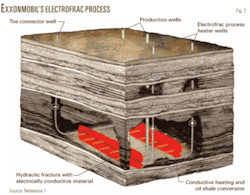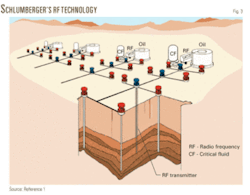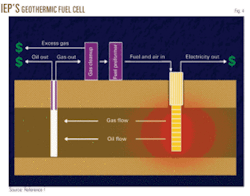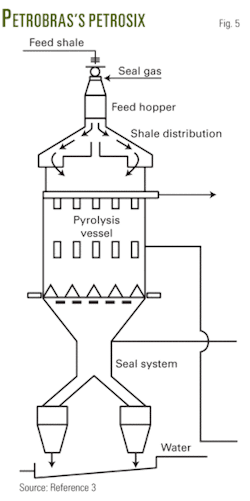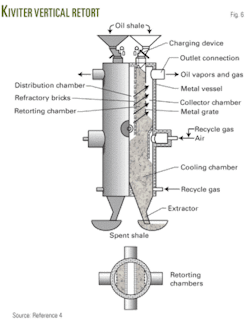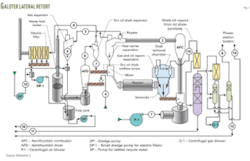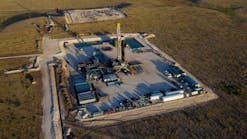Building on past lessons in the US and successful efforts in Estonia, China, and Brazil, developers of oil shale technology are defining, testing, and demonstrating new approaches that overcome past technical issues such as energy use, thermal efficiency, oil yield, gas richness, water use, spent-shale management, emissions controls, and groundwater protection.
These new technologies also take into account the complications posed by global climate change.
More thermally efficient technologies require less energy input, produce higher yields, improve produced shale oil and gas quality, reduce and manage carbon emissions, and protect the environment. These and other innovations promise to improve operability and reliability, while maintaining capital and operating costs that will be competitive with conventional oil and gas.
This article, the second of four, describes the proven and emerging technologies for producing oil and gas from the shale. Part 1 covered the resource base (OGJ, Jan. 19, 2009, p. 56).
In future issues, the third part will discuss the economic viability of the oil shale industry, and the final article will cover the environmental effects of developing oil shale.
Technology development
Industry is making major investments in technology research development and demonstration to advance oil shale technologies and innovations from bench and pilot scale to commercial scale.
Development of US oil shale resources has regained attention in the past few years. Several factors have contributed to this, including high oil prices, emerging recovery technologies, increasing world demand for liquid hydrocarbons, and the continued decline in US conventional oil production.
Numerous companies in the world are developing oil shale technologies. One US Department of Energy report identified more than 30 US companies actively engaged in oil shale technology, resource, or project development.1
Some companies already are applying new technology at small scale (less than 5,000 b/d) in Estonia, Brazil, and China, but little global oil shale production remains at commercial scale; none is in the US.
Numerous approaches during more than 100 years have attempted to develop oil shale resources. These approaches fall into three broad categories: surface, in situ, or hybrid processes.
Surface processes are the most tested and most commonly used. These processes entail three major steps:
- Oil shale mining and ore preparation.
- Pyrolysis of oil shale in kilns or retorts to produce kerogen oil.
- Upgrading kerogen oil to produce refinery feedstocks and high-value chemicals.
Shale for surface retorting may come from either surface or underground mines. The major difficulties for surface processes have involved materials handling, process energy efficiency, and spent-shale disposal.
For deeper, thicker deposits, not as amenable to surface or deep-mining methods, various technologies can produce kerogen oil in situ. In situ processes, by heating the resource in its natural depositional setting, minimize or eliminate the need for mining and surface pyrolysis.
True in situ processes apply heat to the subsurface oil shale resource without mining, and modified in situ processes attempt to improve pyrolysis and recovery efficiency by fracturing or rubblizing some or all of the resource to improve heat transfer and fluid flow through the shale.
The hybrid process is a recent concept that combines surface and in situ approaches. This approach slowly heats oil shale mined from near-surface deposits in a sealed impoundment constructed in the void space created by ore excavation.
Recent advances in oil shale technology are both numerous and groundbreaking. These new variations on the traditional approaches may offer improvements in efficiency, reductions in energy use, reductions in net water use, more efficient capture of regulated emissions, effective carbon management, higher production yields, and-or improved product quality as measured by oil gravity and other standard measures.
Shell’s in situ conversion1
For more than a quarter of a century, Shell Oil Co. in its Mahogany research project has tested an in situ conversion process (ICP) in Colorado. Shell’s technique inserts heaters underground to convert kerogen in oil shale into high-quality transportation fuels, generating more oil and gas from a smaller surface area than previous oil shale processes.
In the ICP process, electric heaters gradually heat shale located 1,000-2,000 ft subsurface, to 650-750° F. The heat changes the kerogen in oil shale into oil and gas. Traditional recovery methods then pump the oil to surface.
Shell expects this slow, lower temperature process to generate lower carbon emissions than traditional surface retorting. The process yields high-quality feedstocks (greater than 30° gravity) with estimated yields in the thickest and richest deposits from 100,000 to 1 million boe/acre.
The tests also include freezewall technology for protecting the heating zone from groundwater intrusion and for protecting the groundwater from potential contamination. After the production area has been cleaned, the freezewall is terminated allowing resumption of groundwater flow.
Fig. 1 displays both the ICP technology and the freeze-wall concept.
ExxonMobil’s Electrofrac1
ExxonMobil Corp.’s Electrofrac process for in situ oil shale conversion involves hydraulically fracturing the shale and filling the fractures with an electrically conductive material, forming a heating element.
Exxon expects the use of vertical fractures created from horizontal wells will produce a conductive zone that when heated to pyrolysis temperature will produce liquids and gases that conventional recovery technologies can produce (Fig. 2).
Petro Probe’s superheated air1
Petro Probe Inc. has licensed an in situ process that can gasify and recover products from oil shale deposits deeper than 3,000 ft. The process begins by drilling into the oil shale and locating a processing inlet conduit within the hole. An effluent conduit is anchored around the opening at surface.
The process then introduces pressurized air to an aboveground combustor, superheating the air and directing it underground into the oil shale through the inlet conduit to heat the rock and convert the kerogen to a gaseous state.
Radiant heat in the inlet conduit produces a nonburning thermal energy front of predictable radius in the oil shale surrounding the hole. High temperatures and correct pressures cause the porous marlstone to gasify. Four products result: hydrogen, 45° gravity condensate; 1,000-btu methane gas, and water.
This is a self-sustaining system with gas being condensed and recycled. In addition, the process includes compressing produced CO2 and pumping it back into the oil shale formation where it remains.
The process has a minimal surface footprint. Each complete plant will cover about 1 acre of land and will deplete the oil shale body in 10-20 years. Subsurface, the formation retains 94% to 99% of its original structural integrity once the kerogen has been gasified.
Schlumberger’s RF technology1
Raytheon Co. and CF Technology Inc. developed an extraction methodology involving radio frequency (RF) and critical fluids. In 2007, the companies sold the integrated technology to Schlumberger Ltd., which plans to commercialize the technology and facilitate its application in heavy oil and oil shale projects.
This in situ technology uses radio frequencies to heat the shale to pyrolysis temperatures and supercritical CO2 to sweep the produced liquids and gases to production wells.
This extraction method uses standard oil industry equipment to drill the wells into the shale strata. Then RF antennas lowered to the shale zone transmit RF energy to heat the shale. Supercritical CO2 pumped into the oil shale extracts the kerogen oil and carries it to an extraction well.
Surface facilities separate out the CO2 and pump it back into injection wells. When refined, the oil and gas become gasoline, heating oil, and other products. Ultimately, the company expects that this self-sequestration approach will yield a neutral carbon footprint for process operations.
This extraction technology can start producing oil and gas within only a few months compared to years of heating required by other in situ processes. The process is tunable in that it allows directing the heat consistently to the desired target and facilitates production of various products.
According to Raytheon, the process may recover 4-5 boe/bbl consumed (Fig. 3). As with the Shell and other approaches, this process requires large quantities of input energy to produce the RF waves.
IEP’s geothermic fuel cell1
Independent Energy Partners (IEP) has developed a heating technology that uses geothermic fuel cell (GFC) to convert kerogen to shale oil, in situ, while using minimal external energy sources. The process involves placement of a high-temperature fuel cell stack in the formation to heat the formation.
As the formation heats, it releases hydrocarbon liquids and gases into collection wells. A portion of the gases are processed and returned to the fuel cell stack, with the rest available for sale.
After an initial warm up period during which the cells are fueled with an external source of natural gas, the process becomes self-fueling from gases liberated by its own waste heat. The system, in steady-state operation, produces oil, electricity, and natural gases.
IEP has designed the GFC to produce a net energy ratio of about 18 units of energy produced/energy unit used. The calculated ratio combines primary recovery with residual char gasification and resulting syntheses gas (Fig. 4).
According to IEP, GFCs heating from solid-to-solid conduction is more efficient than nonconductive applications. GFCs produce heat at a uniform rate along their length and heat the formation uniformly from top to bottom, leading to far greater yields and simplified production cycles.
Raising the formation temperature increases fluid pressure in the heated zone by 100-200 psi over native pressure, which can be enough to fracture oil shale. Alternatively, the operator can prefracture the formation to enhance the hydrocarbon flow and communication between heating and producing wells.
Petrobras’s Petrosix retort
In the 1960s, Petroleo Brasilerio SA (Petrobras) started developing a process to extract oil from pyrobituminous shales, a process it calls Petrosix. This technology is an adaptation of the gas combustion retort (GCR) developed by Cameron Engineers. The Petrosix vertical shaft GCR produces 3,870 b/d of liquids and is the world’s largest operational surface oil shale pyrolysis reactor.
The Petrosix process involves first crushing the mined shale. The crushed shale is then transported to the retort and heated to high temperatures in the top chamber of the GCR. The heated shale releases organic matter in the form of oil and gas vapor.
The next stage cools the vapor allowing it to condense and produce liquids and hydrocarbon gases. Shale gases undergo another cleaning process for light oil extraction (Fig. 5).
The Petrosix process has low water consumption during operation, high thermal efficiency, high operational factor (about 94%), high recovery efficiency (85-90% of Fisher assay), and minimal environmental and health effects.2
The current process operations generate 3,870 b/d of shale oil, 120 tonnes of fuel gas, 45 tonnes of LPG, and 75 tonnes of sulfur from 7,800 tons of shale.1
Fushun retorts
China has expanded shale oil production by increasing the number of small vertical retorts operating at its processing facilities. In 2005, the Fushun facility employed more than 120 retort units, each having a daily throughput capacity of 100 tonnes of oil shale. Grouping the low capacity retorts allows 20 retorts to share a single condenser system.
Like the Petrosix retort, the design allows the use of pyrolized residual carbon to obtain high thermal efficiency. The Fushun design, however, allows introduction of nitrogen in the pyrolysis gas resulting in a produced gas with low calorific value. Introduction of oxygen in the upper chamber makes the pyrolysis less efficient, resulting in oil yields of only about 65% of Fisher assay.2
Expansion of production requires construction of additional batteries of Fushun retorts or adoption of other oil shale technologies. China currently has under evaluation the Petrosix and Alberta Taciuk processes.
Kiviter, Galoter retorts
The Estonian oil shale industry has used two types of retorts (Figs. 6 and 7). The older Kiviter retorts are vertical, lump shale, gas combustion processors, suitable for medium-scale production capacities (1,000 tonnes/day of oil shale) and have oil yields of 75-80% of Fisher assay. The Viru Keemia Group (VKG) has operated two 1,000 tonne/day (tpd) retorts with good results for producing fuels and chemicals.1
The newer Galoter retort design is a horizontal fluidized bed retort with a throughput capacity of about 3,000 tpd (roughly half the capacity of the Petrosix 11-m retort and three times the capacity of the Kiviter). Using shale ash as a solid heat carrier, the process is more thermally efficient, reducing energy inputs, and achieves a higher yield of about 85-90% of Fisher assay. The design also delivers higher quality produced gases.
Although the process is more complex than the Kiviter, plant availability has steadily improved, recently reaching 6,200 hr/year of operating up time.
These designs currently are in use in Estonia and EESTI Energia may consider them for use in Jordan.
Alberta Taciuk process
The Alberta Taciuk process (ATP) involves a horizontal rotating kiln with high thermal efficiency and high production efficiency. It can obtain shale oil production of 90% or greater of Fisher assay.
The process, originally developed in 1976 for treating Alberta oil sands, was later refined for use in oil shale and contaminated waste treatment. A scaled-up commercial version of the process operated in the Stuart deposit in Queensland Australia and produced more than 1.5 million bbl shale oil.
The process combines gas recirculation and direct and indirect heat transfer from circulated hot solids in a rotating kiln. It is largely energy self-sufficient because some of the hot processed shale recirculates in the retort with fresh shale to provide pyrolysis heat by direct, solid-to-solid heat transfer.
ATP has been reported to increase kerogen oil and gas yields, improve thermal efficiency, reduce process water needs, and minimize residual coke on spent shale, enabling environmentally safe disposal (Fig. 8).
References
- Secure Fuels From Domestic Resources, US Department of Energy, August 2008.
- Survey of Energy Resources 2007, World Energy Council, London, September 2007.
- Qian, Jialin, and Wang Jianqiu, “World Oil Shale Retorting Technologies,” International Conference on Oil Shale, Amman, Jordan, November 2006.
- Crawford, P.M., et al., Advances in World Oil Shale Production Technologies, Paper No. SPE 116570, SPE ATCE, Sept. 21-24, 2008.
The authors
Peter M. Crawford (pcrawford @inteki.com) consults in energy technology, policy, and strategic communications as a senior manager for Intek Inc. He is one of the three principal authors of the Strategic Potential of America’s Oil Shale Resources. Crawford holds a BS from Georgetown University.
Emily Knaus ([email protected]) is an associate with Intek Inc. and has more than 4 years of experience in research and analysis in support of DOE programs related to the strategic petroleum reserves and naval petroleum and oil shale reserves. She currently supports efforts of the Task Force on Unconventional Fuels and a DOE effort to evaluate the environmental impacts of an oil shale industry. Knaus has a BA in economics from James Madison University.
Khosrow Biglarbigi’s and James Killen’s photos and biographies appeared in Part 1 of this series.

